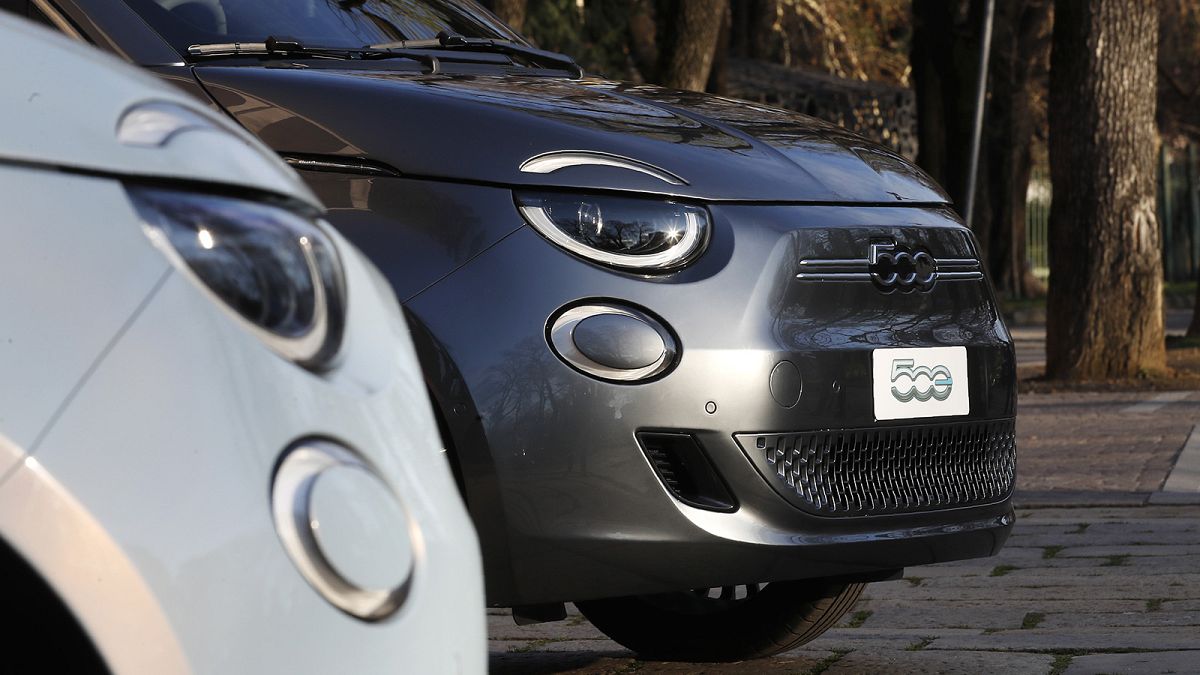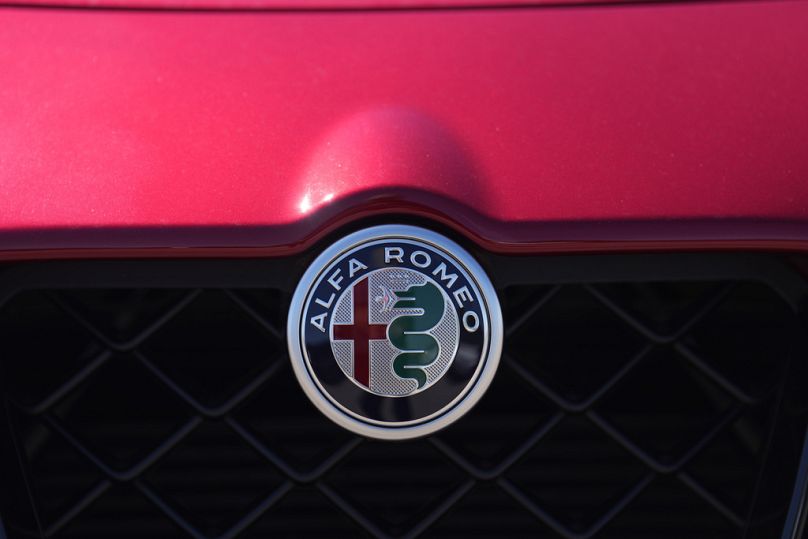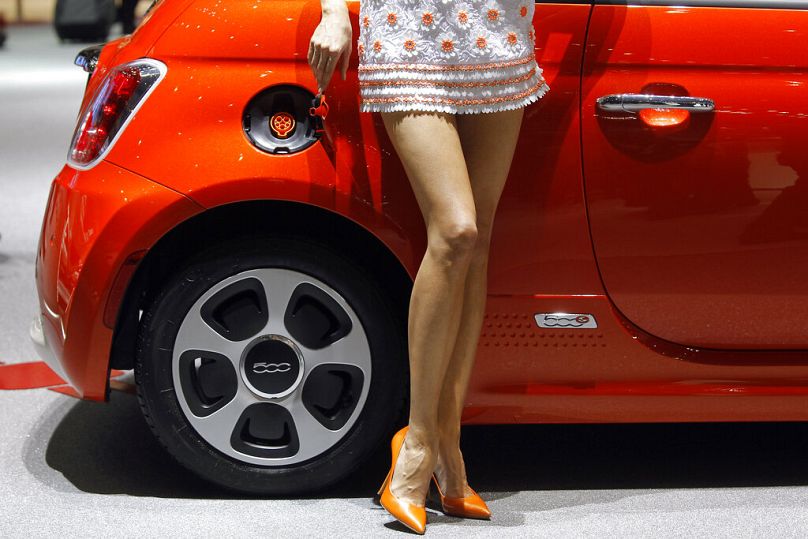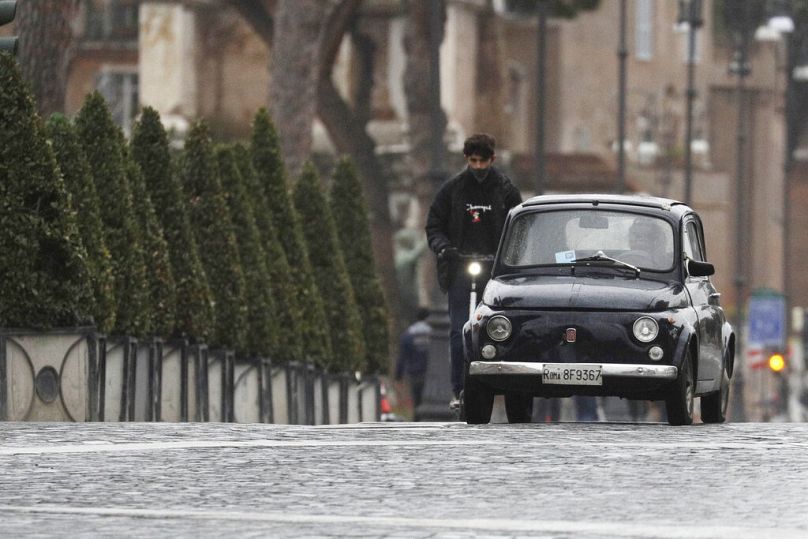The ongoing dispute between Europe’s second-largest car manufacturer and the Italian government continues — this time, with the Fiat 500’s iconic status front and centre.
Audrey Hepburn and Gregory Peck frolicked around Rome in it. Pope Francis chose it over a bulletproof limousine. Italian PM Giorgia Meloni enjoyed a ride in it at the G7 in Puglia just last week.
Now, the iconic Fiat 500 is being used to make a point.
In its latest video advertisement, Stellantis — a Netherlands-based Franco-Italian multinational that designs and manufactures cars under 14 brands, including all of Fiat’s models — showed the ever-popular Cinquecento stripped of all logos.
“If this car had no logo, if it had no name, if it had no flag, if it had nothing to say what it is, or where it comes from, everyone would still recognise it,” a narrator said in the 30-second spot showing off the 500’s famous design.
“It can only be Italian, and it can only be a Fiat,” the ad concluded.
To many, the short ad did nothing more than highlight the instant recognition a Fiat 500 warrants. After all, the tiny yet very practical city car — around since the 1950s and rebooted in 2007 — has become synonymous with chase, romance, and la dolce vita.
Yet to others, it was a not-so-subtle jab at the government in Rome after several recent decisions against the company’s vehicles and their alleged non-Italianness.
Cashing in on Italy’s good name
Stellantis first aggravated the authorities in mid-April, when it announced a new Alfa Romeo — another historic Italian brand it owns — is set to be named "Milano" in honour of Italy's second-largest city, a world-renowned centre of design and fashion.
The Ministry of Enterprises and Made in Italy responded by invoking the so-called “Italian-sounding law”, which bans foreign entities from using names evocative of Italy, its toponyms, or its tricolour flag to promote products made elsewhere.
The law, ironically called “legge Italian-sounding” in Italian, was put in place in 2019 after the national union of small and medium businesses argued that these products caused significant damage to the country’s economy, to the tune of €55 billion a year.
Some saw the move by Made in Italy Minister Adolfo Urso as nothing more than a cheap tactic — or rather, an "excessively pragmatic" one usually reserved for food products, as Italian news agency ANSA journalist Amalia Angotti told Euronews — to put pressure on the car manufacturer to produce more vehicles domestically.
“The Italian government wants Stellantis to produce 1 million vehicles in Italy, otherwise it aims to bring in other car manufacturers, including Asian ones,” Angotti said.
And yet, it's far from true that Italian brands like Fiat, Alfa Romeo, or Lamborghini — another prominent carmaking name now in Stellantis' hands — have no links to Italy. If anything, they are still significantly chipping into the country's budget, she explained.
"Over 63% of the vehicles produced in Stellantis' Italian factories in 2023 were exported abroad, contributing to the Italian trade balance," said Angotti, who has been reporting on Fiat and the Italian car industry for decades.
More importantly, no factories have been moved abroad. If anything, it's all still where it was to begin with — and then some.
Stellantis, part of a larger Exor holding controlled by the family of one of Fiat's founders, Giovanni Agnelli, has 12 factories and 10 research centres in Italy, and it employs 43,000 workers in the country. Just in the last five years, the company invested €5 billion into different ventures across the country, she pointed out.
"So it is not correct to say that Fiat has been sold," Angotti explained, illustrating the international nature of a company still deeply rooted in Italy. "There are many nationalities in top management: the CEO is Portuguese, the head of finance is American, and the head of technology is Croatian."
"Same thing for the brands: the CEO of Jeep is American, that of Peugeot is English, and the head of Alfa Romeo is French."
Another day, another law
Stellantis responded to the Made in Italy Ministry's demands by quickly rebranding its subcompact SUV — set to be made in Slovakia — as the "Junior". The CEO of Alfa Romeo, Jean-Philippe Learnato, told the domestic press the company wanted "to promote a climate of serenity and relaxation".
"It's like having launched two models in a few days, first the Milano and then the Junior," Learnato quipped. "We are truly unique."
Yet despite Learnato's assurances that at least two Alfa Romeo models will be made in Italian factories over the next few years, the Italian government struck against Stellantis once again.
In mid-May, the financial police and customs authorities seized a shipment of 134 Fiat Topolino electric micro-cars — vehicles that can be driven by 14-year-olds with a provisional licence — because they were branded with tiny Italian flag stickers despite being made in Morocco, this time going against several provisions of Italian law.
The main point of contention, according to Italian authorities, was the “substantial transformation” rule, an EU regulation stating that any manufacturing process that significantly alters the end product means that whatever was made (in this case, the tiny Topolino) legally originates from the country that actually put the screws in place.
The Topolino's flag sticker went against another string of recently tightened laws, originating in the old Madrid Convention of 1891, which states that even an indirect misdirection on origin can be seen as an attempt to deceive the buyer. Sure enough, Italian authorities seized a shipment of the vehicles upon its arrival at the port of Livorno.
Fiat responded that it still believed the Italian tricolour was fair game because the Topolino was designed in Turin and merely assembled elsewhere, but it ultimately acquiesced to Rome's orders.
While tensions eased after Stellantis announced it would continue producing the Fiat Panda at its Italian factory in Pomigliano until at least 2030 and manufacture a new hybrid 500 in Turin, it seems that the question of who makes the quintessential Italian vehicles is just the most public part of a much deeper issue: is the Italian government really playing fair by forcing Stellantis to jump through hoops?
'Are we sure about this policy?'
“While it is likely true that the Alfa Romeo Junior is not produced in Italy, there are many cars, especially Japanese ones, using names of Italian cities or related to Italy,” Claudio Dordi, law professor at the Bocconi University in Milan, told Euronews.
“It seems that, in this case, the Italian authorities are applying different standards to Stellantis compared to other car producers.”
Asked whether Italy was doing the right thing by enforcing its laws so strictly, Dordi said he was not convinced.
“Even applying the ‘substantial transformation’ rule, we might qualify products with quite a high foreign content — in some cases, even more than 50% — as Italian.”
“Conversely, there are products that cannot be considered Italian but include a high value of Italian origin. Protecting only those products considered 'Italian' might have a counterproductive impact," he explained.
This practice makes even less sense in the globalised world of the 21st century, where countries — especially those in the EU — need to keep all doors open to potential collaboration if they want to bolster their economies.
“Given that the production chains of almost all products are spread across different countries, are we sure that this policy effectively promotes the Italian interests? For instance, there are several cars produced worldwide based on Italian design,” Dordi pointed out.
“Shouldn’t Italy focus more on attracting foreign investment or convincing former Italian companies to reinvest in Italy by improving the local business, legal, and administrative environment?”















